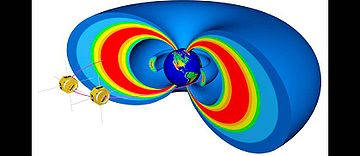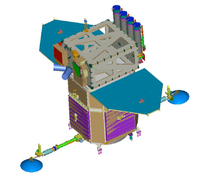
Living With a Star
Encyclopedia
Living With a Star is a NASA
scientific program to study those aspects of the connected Sun
-Earth
system that directly affect life and society. LWS is a crosscutting initiative with goals and objectives relevant to NASA's Exploration Initiative, as well as to NASA's Strategic Enterprises. The program is managed by the Heliophysics Division of NASA's Science Mission Directorate.
LWS is composed of three major components: Scientific investigations on spaceflight platforms study different regions of the Sun, interplanetary space, and geospace; an applied science program Space Environment Testbeds where protocols and
components are tested; and a Targeted Research and Technology Program.
(SDO) and
Radiation Belt Storm Probes
(RBSP). The SDO mission launched on February 11, 2010.

 Science requirements and conceptual mission implementation have been defined for the Ionosphere-Thermosphere Storm Probes
Science requirements and conceptual mission implementation have been defined for the Ionosphere-Thermosphere Storm Probes
(ITSP) and the Solar Sentinels
.
Define the mechanisms for induced space environment and effects;
reduce uncertainties in the definitions of the induced environment and effects on spacecraft and their payloads; and to
improve design and operations guidelines and test protocols so that spacecraft anomalies and failures due to environmental effects during operations are reduced.
society. To provide immediate progress toward achieving the LWS goals, the Targeted Research and Technology (TR&T) component of the program was developed. The TR&T element has solicited five rounds of proposals seeking quantitative understanding and predictive capability throughout the system. TR&T has funded independent research awards, focused science topic panels, and strategic capability challenges to enable a cross-disciplinary, integrated, system-wide understanding of how the Sun varies, and how Earth and planets respond. The focused science topic panels are a novel approach to collaborative science, and initial results appear promising.
NASA
The National Aeronautics and Space Administration is the agency of the United States government that is responsible for the nation's civilian space program and for aeronautics and aerospace research...
scientific program to study those aspects of the connected Sun
Sun
The Sun is the star at the center of the Solar System. It is almost perfectly spherical and consists of hot plasma interwoven with magnetic fields...
-Earth
Earth
Earth is the third planet from the Sun, and the densest and fifth-largest of the eight planets in the Solar System. It is also the largest of the Solar System's four terrestrial planets...
system that directly affect life and society. LWS is a crosscutting initiative with goals and objectives relevant to NASA's Exploration Initiative, as well as to NASA's Strategic Enterprises. The program is managed by the Heliophysics Division of NASA's Science Mission Directorate.
LWS is composed of three major components: Scientific investigations on spaceflight platforms study different regions of the Sun, interplanetary space, and geospace; an applied science program Space Environment Testbeds where protocols and
components are tested; and a Targeted Research and Technology Program.
Spaceflight Segment
The first two science missions are now in development: Solar Dynamics ObservatorySolar Dynamics Observatory
The Solar Dynamics Observatory is a NASA mission which will observe the Sun for over five years. Launched on February 11, 2010, the observatory is part of the Living With a Star program...
(SDO) and
Radiation Belt Storm Probes
Radiation Belt Storm Probes
The Radiation Belt Storm Probes is a NASA mission under the Living With a Star program. The goal of the LWS program is to develop the scientific understanding necessary to effectively address those aspects of the connected Sun-Earth system that directly affect life and society...
(RBSP). The SDO mission launched on February 11, 2010.


Ionosphere-Thermosphere Storm Probes
The Ionosphere-Thermosphere Storm Probes is a NASA mission which will study the ionosphere and the thermosphere. This mission is part of the Living With a Star program, the second mission in a pair of geospace missions...
(ITSP) and the Solar Sentinels
Solar Sentinels
The Solar Sentinels is a space mission to study the Sun during its solar maximum, the last before the beginning of the Orion program. Six spacecraft will be launched, which will separate into three groups...
.
Space Environment Testbeds
SET uses existing data and new data from low-cost SET missions to achieve the following:Define the mechanisms for induced space environment and effects;
reduce uncertainties in the definitions of the induced environment and effects on spacecraft and their payloads; and to
improve design and operations guidelines and test protocols so that spacecraft anomalies and failures due to environmental effects during operations are reduced.
Targeted Research and Technology (TR&T)
With the 2001 inception of the LWS Program, new opportunities were created for a systematic, goal-oriented research program targeting those aspects of the Sun-Earth system that affect life andsociety. To provide immediate progress toward achieving the LWS goals, the Targeted Research and Technology (TR&T) component of the program was developed. The TR&T element has solicited five rounds of proposals seeking quantitative understanding and predictive capability throughout the system. TR&T has funded independent research awards, focused science topic panels, and strategic capability challenges to enable a cross-disciplinary, integrated, system-wide understanding of how the Sun varies, and how Earth and planets respond. The focused science topic panels are a novel approach to collaborative science, and initial results appear promising.
Missions
The following are missions that are currently being undertaken, or are being planned by the Living With a Star program.- Solar Dynamics ObservatorySolar Dynamics ObservatoryThe Solar Dynamics Observatory is a NASA mission which will observe the Sun for over five years. Launched on February 11, 2010, the observatory is part of the Living With a Star program...
(SDO) - Radiation Belt Storm ProbesRadiation Belt Storm ProbesThe Radiation Belt Storm Probes is a NASA mission under the Living With a Star program. The goal of the LWS program is to develop the scientific understanding necessary to effectively address those aspects of the connected Sun-Earth system that directly affect life and society...
- BARREL (Balloon Array for RBSP Relativistic Electron Losses)BARREL (Balloon Array for RBSP Relativistic Electron Losses)Balloon Array for RBSP Relativistic Electron Losses is a NASA mission operated out of Dartmouth that will work with the Radiation Belt Storm Probes mission due to launch in 2012. The BARREL project will launch 20 balloons at a time from Antarctica in several launches over 2012 to 2014...
- Solar Probe Plus
- Radiation Belt Storm ProbesRadiation Belt Storm ProbesThe Radiation Belt Storm Probes is a NASA mission under the Living With a Star program. The goal of the LWS program is to develop the scientific understanding necessary to effectively address those aspects of the connected Sun-Earth system that directly affect life and society...
- Solar OrbiterSolar OrbiterSolar Orbiter is a planned Sun-observing satellite, under development by the European Space Agency . The main mission scenario is a launch by an Atlas V from the Kennedy Space Center in Florida in January 2017...
- Space Environmental Testbeds

